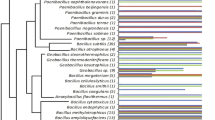Abstract
A systematic analysis of beta-lactamases based on comparative proteomics has not been performed thus far. In this report, we searched for the presence of beta-lactam-related proteins in 591 bacterial proteomes belonging to 52 species that are pathogenic to humans. The amino acid sequences for 19 different types of beta-lactamases (ACT, CARB, CifA, CMY, CTX, FOX, GES, GOB, IMP, IND, KPC, LEN, OKP, OXA, OXY, SHV, TEM, NDM, and VIM) were obtained from the ARG-ANNOT database and were used to construct 19 HMM profiles, which were used to identify potential beta-lactamases in the completely sequenced bacterial proteomes. A total of 2877 matches that included the word “beta-lactamase” and/or “penicillin” in the functional annotation and/or in any of its regions were obtained. These enzymes were mainly described as “penicillin-binding proteins,” “beta-lactamases,” and “metallo-beta-lactamases” and were observed in 47 of the 52 species studied. In addition, proteins classified as “beta-lactamases” were observed in 39 of the species included. A positive correlation between the number of beta-lactam-related proteins per species and the proteome size was observed (R 0.78, P < 0.00001). This correlation partially explains the high presence of beta-lactam-related proteins in large proteomes, such as Nocardia brasiliensis, Bacillus anthracis, and Mycobacterium tuberculosis, along with their absence in small proteomes, such as Chlamydia spp. and Mycoplasma spp. We detected only five types of beta-lactamases (TEM, SHV, CTX, IMP, and OXA) and other related proteins in particular species that corresponded with those reported in the literature. We additionally detected other potential species-specific beta-lactamases that have not yet been reported. In the future, better results will be achieved due to more accurate sequence annotations and a greater number of sequenced genomes.

Similar content being viewed by others
References
Abraham S, Wong HS, Turnidge J, Johnson JR, Trott DJ (2014) Carbapenemase-producing bacteria in companion animals: a public health concern on the horizon. J Antimicrob Chemother 69:1155–1157
Barbour AG, Amano K, Hackstadt T, Perry L, Caldwell HD (1982) Chlamydia trachomatis has penicillin-binding proteins but not detectable muramic acid. J Bacteriol 151:420–428
Bush K (2013) Proliferation and significance of clinically relevant β-lactamases. Ann N Y Acad Sci 1277:84–90
Cantón R, Coque TM (2006) The CTX-M beta-lactamase pandemic. Curr Opin Microbiol 9:466–475
Cha JY, Ishiwata A, Mobashery S (2004) A novel beta-lactamase activity from a penicillin-binding protein of Treponema pallidum and why syphilis is still treatable with penicillin. J Biol Chem 279:14917–14921
Chroma M, Kolar M (2010) Genetic methods for detection of antibiotic resistance: focus on extended-spectrum β-lactamases. Biomed Pap Med Fac Univ Palacky Olomouc Czech Repub 154:289–296
Daiyasu H, Osaka K, Ishino Y, Toh H (2001) Expansion of the zinc metallo-hydrolase family of the beta-lactamase fold. FEBS Lett 503:1–6
Flandrois JP, Lina G, Dumitrescu O (2014) MUBII-TB-DB: a database of mutations associated with antibiotic resistance in Mycobacterium tuberculosis. BMC Bioinform 15:107
Gniadkowski M (2008) Evolution of extended-spectrum beta-lactamases by mutation. Clin Microbiol Infect 1:11–32
Gupta SK, Padmanabhan BR, Diene SM, Lopez-Rojas R, Kempf M, Landraud L, Rolain JM (2014) ARG-ANNOT, a new bioinformatic tool to discover antibiotic resistance genes in bacterial genomes. Antimicrob Agents Chemother 58:212–220
Joss MJ, Koenig JE, Labbate M, Polz MF, Gillings MR, Stokes HW, Doolittle WF, Boucher Y (2009) ACID: annotation of cassette and integron data. BMC Bioinform 10:118
Limphong P, Nimako G, Thomas PW, Fast W, Makaroff CA, Crowder MW (2009) Arabidopsis thaliana mitochondrial glyoxalase 2-1 exhibits beta-lactamase activity. Biochemistry 48:8491–8493
McArthur AG, Waglechner N, Nizam F, Yan A, Azad MA, Baylay AJ, Bhullar K, Canova MJ, De Pascale G, Ejim L et al (2013) The comprehensive antibiotic resistance database. Antimicrob Agents Chemother 57:3348–3357
Motley M, Sarafian SK, Knapp JS, Zaidi AA, Schmid G (1992) Correlation between in vitro antimicrobial susceptibilities and beta-lactamase plasmid contents of isolates of Haemophilus ducreyi from the United States. Antimicrob Agents Chemother 36:1639–1643
Moura A, Soares M, Pereira C, Leitão N, Henriques I, Correia A (2009) INTEGRALL: a database and search engine for integrons, integrases and gene cassettes. Bioinformatics 25:1096–1098
Queenan AM, Bush K (2007) Carbapenemases: the versatile beta-lactamases. Clin Microbiol Rev 20:440–458
Rice LB (2012) Mechanisms of resistance and clinical relevance of resistance to β-lactams, glycopeptides, and fluoroquinolones. Mayo Clin Proc 87:198–208
Singh G, Kumar A, Arya S, Gupta UD, Singh K, Kaur J (2016) Characterization of a novel esterase Rv1497 of Mycobacterium tuberculosisH37Rv demonstrating β-lactamase activity. Enzyme Microb Technol 82:180–190
Trott D (2013) β-lactam resistance in gram-negative pathogens isolated from animals. Curr Pharm Des 19:239–249
Tsafnat G, Copty J, Partridge SR (2011) RAC: repository of antibiotic resistance cassettes. database (Oxford) 2011: bar054
Zhou CE, Smith J, Lam M, Zemla A, Dyer MD, Slezak T (2007) MvirDB–a microbial database of protein toxins, virulence factors and antibiotic resistance genes for bio-defence applications. Nucleic Acids Res 35:D391–D394
Acknowledgements
We wish to thank to CONACyT for the scholarship granted to AJLBT to perform the present study. The publication of this article was partially funded by DGAPA-UNAM (IN-201117) to E. P-R.
Author information
Authors and Affiliations
Corresponding authors
Electronic supplementary material
Below is the link to the electronic supplementary material.
Rights and permissions
About this article
Cite this article
Brambila-Tapia, A.J.L., Perez-Rueda, E., Barrios, H. et al. Identification of beta-Lactamases and beta-Lactam-Related Proteins in Human Pathogenic Bacteria using a Computational Search Approach. Curr Microbiol 74, 915–920 (2017). https://doi.org/10.1007/s00284-017-1265-3
Received:
Accepted:
Published:
Issue Date:
DOI: https://doi.org/10.1007/s00284-017-1265-3




